Desert locust
The desert locust (Schistocerca gregaria[1][2][3]) is a species of locust, a periodically swarming short-horned grasshopper in the family Acrididae. They are found mainly in Africa, through Arabia, West Asia and extending into parts of South Asia. During population surge years, they may extend into parts of western Spain. The desert locust shows periodic changes in the body form and can change, in response to environmental conditions, over generations, from a solitary, shorter winged, highly fecund non-migratory form to a gregarious, long winged and migratory phase in which they may travel long distances into new areas. In some years they may thus form locust plagues, invading new areas, where they may consume all vegetation including crops and at other times, they may live unnoticed in small numbers.
| Desert locust | |
|---|---|
 | |
| A migratory phase adult laying eggs | |
| Scientific classification | |
| Kingdom: | Animalia |
| Phylum: | Arthropoda |
| Class: | Insecta |
| Order: | Orthoptera |
| Suborder: | Caelifera |
| Family: | Acrididae |
| Subfamily: | Cyrtacanthacridinae |
| Tribe: | Cyrtacanthacridini |
| Genus: | Schistocerca |
| Species: | S. gregaria |
| Binomial name | |
| Schistocerca gregaria Forsskål, 1775 | |
| Synonyms | |
| |
During plague years, desert locusts can cause widespread damage to crops, as they are highly mobile and feed on large quantities of any kind of green vegetation, including crops, pasture, and fodder. A typical swarm can be made up of 150 million locusts per square kilometer and fly in the direction of the prevailing wind,[4] up to 150 km in one day. Even a very small, one-square-kilometer locust swarm can eat the same amount of food in a day as about 35,000 people.[5]
As an international transboundary pest that threatens agricultural production and livelihoods in many countries in Africa, the Middle East and South Asia, their populations have been routinely monitored through collaborations between countries through the United Nations Food and Agriculture Organization. Its migratory nature and capacity for rapid population growth present major challenges for control, particularly in remote semiarid areas, which characterize much of the distribution area.[6]
Locusts differ from other grasshoppers in their ability to change from a solitary living form into gregarious, highly mobile, adult swarms and hopper bands as their numbers and densities increase. They exist in different states known as recessions (with low and intermediate numbers), rising to outbreaks, and extremely high densities or plagues. They have two to five generations per year. The desert locust risk increases with one-to-two-year continuum of favourable weather (greater frequency of rains) and habitats that support population increases leading to upsurges and plagues.[7]
The desert locust is potentially the most dangerous of the locust pests because of the ability of swarms to fly rapidly across great distances. The major desert locust upsurge in 2004–05 caused significant crop losses in West Africa and diminished food security in the region.
In February 2020, the UN Food and Agriculture Organisation announced that desert locusts are destroying tens of thousands of hectares of crops and grazing land in North East Africa in the worst invasion in 25 years. The UN warns that a dangerous situation is now facing the region and in particular eastern Ethiopia.[8] Since this announcement, swarms have caused Somalia to declare a state of emergency[9] and spread to other East African countries like Kenya, Uganda, Tanzania,[10] and most recently South Sudan.[11]
Description
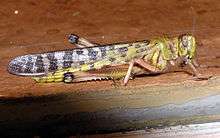
The genus Schistocerca consists of more than thirty species which are distributed in Africa, Asia, North and South America and many species are difficult to identify due to the presence of variable morphs. It is the only genus within the Cyrtacanthacridinae that occurs in both the New and Old World. Most species have the fastigium deflexed and lacking lateral carinae on the pronotum. The hind tibiae have smooth margins with numerous spines but have no apical spine on the outer margin. The second tarsal segment is half as long as the first. Males in the genus have broad anal cerci and a split subgenital plate. The genus is thought to have originated in Africa and then speciated in the New World after a dispersal event that took place 6 to 7 million years ago.[12][13][14]
The solitary phase (or solitaria morph) are greenish in early instars while older adults are greyish. The solitary phase grasshoppers lack black patterning as present in the gregarious (or gregaria morph) phase where the body is pinkish in early instars and yellow in adults.[15]
Life cycle
The life cycle of the desert locust consists of three stages, the egg, the nymph known as a hopper, and the winged adult. Copulation takes place when a mature male hops onto the back of a mature female and grips her body with his legs. Sperm is transferred from the tip of his abdomen to the tip of hers, where it is stored. The process takes several hours and one insemination is sufficient for a number of batches of eggs.[16]
The female locust then seeks suitable soft soil in which to lay her eggs. It needs to be the right temperature and degree of dampness and be in close proximity to other egg-laying females. She probes the soil with her abdomen and digs a hole into which an eggpod containing up to a hundred eggs is deposited. The egg pod is 3 to 4 cm (1.2 to 1.6 in) long and the lower end is about 10 cm (4 in) below the surface of the ground. The eggs are surrounded by foam and this hardens into a membrane and plugs the hole above the egg pod. The eggs absorb moisture from the surrounding soil. The incubation period before the eggs hatch may be two weeks or much longer, depending on the temperature.[16]
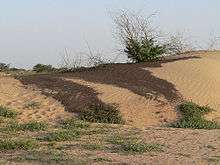
The newly hatched nymph soon begins to feed and, if it is a gregarious individual, is attracted to other hoppers and they group together. As it grows it needs to moult (shed its exoskeleton). Its hard cuticle splits and its body expands while the new exoskeleton is still soft. The stages between moulting are called instars and the desert locust nymph undergoes five moults before becoming a winged adult. Immature and mature individuals in the gregarious phase form bands which feed, bask and move as cohesive units, while solitary phase individuals do not seek gregariousness.[16][17]
After the fifth moult the insect is said to have fledged but it is not yet mature. It is at first soft and pink with drooping wings, but over the course of a few days, the cuticle hardens and haemolymph is pumped into the wings which stiffen them. Maturation can occur in two to four weeks when the food supply and weather conditions are suitable, but may take as long as six months when they are less ideal. Males start maturing first and give off an odour which stimulates maturation in the females. On maturing the insects turn yellow and the abdomens of the females start swelling with developing eggs.[16]
Ecology and swarming
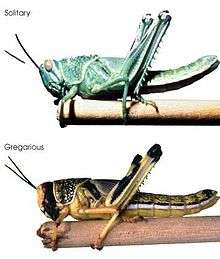
_-_Emil_Schmidt.jpg)
Desert locusts have two phases, the solitary phase and the gregarious phase. This is a type of polyphenism. It has been shown that solitary locusts nymphs and adults can behave gregariously within a few hours of being placed in a crowded situation, while it takes gregarious locusts one or more generations to become solitary when reared in isolation.[17] There are differences in morphology and behaviour between the two phases. In the solitary phase the hoppers do not group together into bands but move about independently. Their colouring in the later instars tends to be greenish or brownish to match the colour of the herbage. The adults fly at night and are also coloured so as to blend into their surroundings, the immature adults being grey or beige and the mature adults being a pale yellowish colour. In the gregarious phase the hoppers bunch together and in the later instars develop a bold colouring with black markings on a yellow background. The immatures are pink and the mature adults are bright yellow and fly during the day in dense swarms.[16]
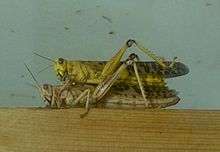
The change from an innocuous solitary insect to a voracious gregarious one normally follows a period of drought, when rain falls and vegetation flushes occur in major desert locust breeding locations. The population builds up rapidly and the competition for food increases.[18] As hoppers get more crowded, the close physical contact causes the insects' hind legs to bump against one another. This stimulus triggers a cascade of metabolic and behavioral changes that cause the insects to transform from the solitary to the gregarious phase. When the hoppers become gregarious, their colouration changes from largely green to yellow and black, and the adults change from brown to pink (immature) or yellow (mature). Their bodies become shorter, and they give off a pheromone that causes them to be attracted to each other, enhancing hopper band and subsequently swarm formation. The nymphal pheromone is different from the adult one. When exposed to the adult pheromone, hoppers become confused and disoriented, because they can apparently no longer "smell" each other, though the visual and tactile stimuli remain. After a few days, the hopper bands disintegrate and those that escape predation become solitary again. It is possible that this effect could aid locust control in the future.
During quiet periods, called recessions, desert locusts are confined to a 16-million-square-kilometer belt that extends from Mauritania through the Sahara Desert in northern Africa, across the Arabian Peninsula, and into northwest India. Under optimal ecological and climatic conditions, several successive generations can occur, causing swarms to form and invade countries on all sides of the recession area, as far north as Spain and Russia, as far south as Nigeria and Kenya, and as far east as India and southwest Asia. As many as 60 countries can be affected within an area of 32 million square kilometers, or approximately 20 percent of the Earth's land surface.
Locust swarms fly with the wind at roughly the speed of the wind. They can cover from 100 to 200 kilometers in a day, and will fly up to about 2,000 meters above sea level (it becomes too cold at higher altitudes). Therefore, swarms cannot cross tall mountain ranges such as the Atlas, the Hindu Kush or the Himalayas. They will not venture into the rain forests of Africa nor into central Europe. However, locust adults and swarms regularly cross the Red Sea between Africa and the Arabian Peninsula, and are even reported to have crossed the Atlantic Ocean from Africa to the Caribbean in ten days during the 1987-89 plague.[19] A single swarm can cover up to 1200 square kilometers and can contain between 40 and 80 million locusts per square kilometer (a total of around 50 to 100 billion locusts per swarm, representing 100,000 to 200,000 tons, considering an average mass of 2 grams per locust). The locust can live between three and six months, and there is a ten to 16-fold increase in locust numbers from one generation to the next.
Crop loss
It is estimated that desert locusts consume the equivalent of their body weight (2 g (0.07 oz)) each day in green vegetation. They are polyphagous and feed on leaves, shoots, flowers, fruit, seeds, stems and bark. Nearly all crops, and noncrop plants, are eaten including pearl millet, maize, sorghum, barley, rice, pasture grasses, sugarcane, cotton, fruit trees, date palms, banana plants, vegetables and weeds.[18]
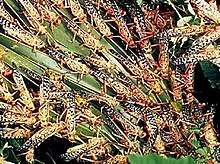
Crop loss from locusts was noted in the Bible and Qur'an; these insects have been documented as contributing to the severity of a number of Ethiopian famines. Since the twentieth century, desert locust plagues occurred from 1926–1934, 1940–1948, 1949–1963, 1967–1969, 1987–1989, 2003-2005 and 2019-2020.[20] In March–October 1915, a plague of locusts stripped Ottoman Palestine of almost all vegetation.[21] The significant crop loss caused by swarming desert locusts exacerbates problems of food shortage, and is a threat to food security.
Control
Early warning and preventive control is the strategy adopted by locust-affected countries in Africa and Asia to try to stop locust plagues from developing and spreading. In the 1920s-1930s, locust control became a major field for international cooperation. The International Agricultural Institute developed several programmes aimed at exchanging data about the desert locust and international conferences were held in the 1930s: Rome in 1931, Paris in 1932, London in 1934, Cairo in 1936 and Brussels in 1938. Colonial empires were heavily involved in these attempts to control locust pests which affected heavily the Middle East and parts of Africa.[22] The USSR also used locust control as a way to expand its influence in the Middle East and Central Asia.[23]
FAO's Desert Locust Information Service (DLIS) in Rome, Italy monitors the weather, ecological conditions and the locust situation on a daily basis. DLIS receives results of survey and control operations carried out by national teams in affected countries, and combines this information with satellite data such as MODIS, rainfall estimates and seasonal temperature and rainfall predictions to assess the current situation and forecast the timing, scale and location of breeding and migration up to six weeks in advance. The situation assessments and forecasts are published in monthly locust bulletins that date back to the 1970s. These are supplemented by warnings and alerts to affected countries and the international community. Those since the 1990s are available on the FAO Locust Watch web site. FAO also provides information and training to affected countries and coordinates funding from donor agencies in case of major upsurges and plagues.
The desert locust is a difficult pest to control, and control measures are further compounded by the large and often remote areas (16-30 million km²) where locusts can be found. Undeveloped basic infrastructure in some affected countries, limited resources for locust monitoring and control, and political turmoil within and between affected countries further reduce the capacity of a country to undertake the necessary monitoring and control activities.
At present, the primary method of controlling desert locust infestations is with insecticides applied in small concentrated doses by vehicle-mounted and aerial sprayers at ultra-low volume (ULV) rates of application. The insecticide is acquired by the insect directly or via secondary pickup (i.e. walking over or eating the residue on a plant). Control is undertaken by government agencies in locust-affected countries or by specialized organizations such as the Desert Locust Control Organization for East Africa (DLCO-EA).
The desert locust has natural enemies such as predatory wasps and flies, parasitoid wasps, predatory beetle larvae, birds and reptiles. These may be effective at keeping solitary populations in check but are of limited effects against gregarious desert locusts because of the enormous numbers of insects in the swarms and hopper bands.[18]
Farmers often try mechanical means of killing locusts, such as digging trenches and burying hopper bands, but this is very labour-intensive and is difficult to undertake when large infestations are scattered over a wide area. Farmers also try to scare locust swarms away from their fields by making noise, burning tires or other methods. This tends to shift the problem to neighbouring farms, and locust swarms can easily return to reinfest previously visited fields.
Biopesticides
Biopesticides include fungi, bacteria, neem extract and pheromones. The effectiveness of many biopesticides equals that of conventional chemical pesticides, but there are two distinct differences. Biopesticides in general take longer to kill insects, plant diseases, or weeds, usually between 2 and 10 days.
There are two types of biopesticides - biochemical and microbial. Biochemical pesticides are similar to naturally occurring chemicals and are nontoxic, such as insect pheromones used to locate mates, while microbial biopesticides, come from bacteria, fungi, algae or viruses that either occur naturally or are genetically altered. Entomopathogenic fungi generally suppress pests by mycosis: causing a disease that is specific to the insect.
Biological control products have been under development since the late nineties; Green Muscle and NOVACRID are based on a naturally occurring entomopathogenic fungus (i.e. insects-infecting fungus), Metarhizium acridum. Species of Metarhizium are widespread throughout the world, infecting many groups of insects, but show a low risk to humans, other mammals and birds. The species M. acridum has specialised on short-horned grasshoppers, to which group locusts belong, and has therefore been chosen as the active ingredient of the product.
The product is available in Australia under the name Green Guard and in Africa, it used to be available as Green Muscle. However, since Green Muscle seems to have disappeared from the market, another product, NOVACRID, was developed for Africa, Central Asia and the Middle East. These products are applied in the same way as chemical insecticides, but do not kill as quickly. At recommended doses, the fungus can take up two weeks to kill up to 90% of the locusts. For that reason, it is recommended for use mainly against hoppers, the wingless early stages of locusts. These are mostly found in the desert, far from cropping areas, where the delay in death does not result in damage. The advantage of the product is that it affects only grasshoppers and locusts, which makes it much safer than chemical insecticides. Specifically, it allows the natural enemies of locusts and grasshoppers to continue their beneficial work. These include birds, parasitoid and predatory wasps, parasitoid flies and certain species of beetles. Though natural enemies cannot prevent plagues, they can limit the frequency of outbreaks and contribute to their control. Biopesticides are also safer to use in environmentally sensitive areas such as national parks or near rivers and other water bodies.
Green Muscle was developed under the LUBILOSA Programme, which was initiated in 1989 in response to environmental concerns over the heavy use of chemical insecticides to control locusts and grasshoppers during the 1987-89 plague. The project focused on the use of beneficial disease-causing microorganisms (pathogens) as biological control agents for grasshoppers and locusts. These insects were considered to be too mobile and to reproduce too fast to be readily controlled by classical biological control. Pathogens have the advantage that many can be produced in artificial culture in large quantities and be used with ordinary spraying equipment. Entomopathogenic fungi were traditionally seen as needing humid conditions to work well. However, the LUBILOSA Programme found a way to avoid this by spraying fungal spores in an oil formulation. Even under desert conditions, Green Muscle can be used to kill locusts and other Acridid pests, such as the Senegalese grasshopper. During trials in Algeria and Mauritania in 2005 and 2006, various natural enemies, but especially birds, were abundant enough to eliminate treated hopper bands in about a week, because the diseased hoppers became sluggish and easy to catch.
Desert locust upsurges
1915 Ottoman Syria locust infestation
From March to October 1915, swarms of locusts stripped areas in and around Palestine, Mount Lebanon and Syria of almost all vegetation. This infestation seriously compromised the already-depleted food supply of the region and sharpened the misery of all Jerusalemites.[24]
2003–2005 desert locust upsurge (West Africa)
From October 2003 to May 2005, West Africa faced the largest desert locust outbreak in 15 years. The upsurge started as small independent outbreaks that developed in Mauritania, Mali, Niger and Sudan in the autumn of 2003. Two days of unusually heavy rains that stretched from Dakar, Senegal to Morocco in October allowed breeding conditions to remain favourable for the next six months and the desert locusts rapidly increased. Lack of rain and cold temperatures in the winter breeding area of northwest Africa in early 2005 slowed the development of the locusts and allowed the locust control agencies to stop the cycle. During the upsurge, nearly 130,000 km² were treated by ground and aerial operations in more than 20 countries. The costs of fighting this upsurge have been estimated by the FAO to have exceeded US$400 million, and harvest losses were valued at up to US$2.5 billion, which had disastrous effects on the food security situation in West Africa.
The countries affected by the 2004 outbreak were Algeria, Burkina Faso, the Canary Islands, Cape Verde, Chad, Egypt, Ethiopia, the Gambia, Greece, Guinea, Guinea Bissau, Israel, Jordan, Lebanon, Libyan Arab Jamahiriya, Mali, Mauritania, Morocco, Niger, Saudi Arabia, Senegal, Sudan, Syria and Tunisia.
2019–20 East Africa and Asia infestation
Since January 2020, a very large population of desert locust gathered in Kenya. Agriculture officials estimate that 5,000 square kilometers (km2.) of pasture and cropland have so far been destroyed by locusts in Mandera, Marsabit, Wajir, Isiolo, Meru and Samburu counties. The insects had covered more than 10,000 km2. of land in Kenya by 2020 Jan 20, and had reached the Eastern regions of Machakos county, Ethiopia, Somalia, South Sudan.[25] As of January 2020 it is a serious problem in East Africa particularly in Uganda and Kenya.[26]
On February the UN stated that the swarms are the largest in Somalia and Ethiopia in 25 years.[27] The swarm spread into east Africa from war-torn Yemen,[28] after heavy rainfall in late 2019 created ideal conditions for the insects to flourish, and as of February 2nd, Somalia is the first country in the region to declare an emergency over the infestation. [29]
On 1 February 2020, the Pakistani government declared a national emergency to counter an invasion of desert locusts that are destroying crops.[30]
Locusts have been migrating from Africa to Pakistan, and have reached India, as of May 27, 2020. They have spread widely due to availability of crops from one place to another. The states widely affected are Rajasthan, Gujarat, Madhya Pradesh, Haryana, Maharastra, Uttar Pradesh and Punjab. "There is a continuous locust invasion from Pakistan. It is not a new problem and we have been facing it for a long time. This year, the locusts attack is worse in 26 years. However, a coordinated effort has been made to curb its spread," a senior official from the Faridabad-headquartered LWO told news agency PTI.[31]
In culture
Owing to the destructive habits of locusts, they have been a representation of famine in many Middle Eastern cultures, and is seen in the movies The Mummy (1999) and The Bible (1966).
This species has been identified as one of the kosher species of locusts mentioned in Leviticus 11:22 by several rabbinical authorities among Middle Eastern Jewish communities.
Locust pheromone
Guaiacol is produced in the gut of Desert locusts by the breakdown of plant material. This process is undertaken by the gut bacterium Pantoea (Enterobacter) agglomerans. Guaiacol is one of the main components of the pheromones that cause locust swarming.[32]
References
- "species Schistocerca gregaria (Forskål, 1775): Orthoptera Species File". orthoptera.speciesfile.org. Retrieved 2020-02-16.
- "Schistocerca gregaria (Desert locust) (Gryllus gregarius)". www.uniprot.org. Retrieved 2020-02-16.
- Forsskål, Peter; Niebuhr, Carsten; Pre-1801 Imprint Collection (Library of Congress) DLC (1775). Descriptiones animalium, avium, amphibiorum, piscium, insectorum, vermium;. Ghent University. Hauniæ, ex officina Mölleri.
- Draper, J. (1980). "The Direction of Desert Locust Migration". Journal of Animal Ecology. 49 (3): 959–974. doi:10.2307/4238. JSTOR 4238.
- "FAO and partners stress urgent need on Desert Locust Response". www.fao.org. Retrieved 2020-02-16.
- "No. 27: Economic and policy issues in Desert Locust management (S. Joffe, 1998)". www.fao.org. Retrieved 2020-02-16.
- DLCEO-EA. "Desert Locust". dlco-ea.org. Retrieved 2020-02-16.
- "FAO and partners stress urgent need on Desert Locust Response". www.fao.org. Retrieved 2020-02-16.
- "Somalia declares emergency over locust swarms". BBC News. 2020-02-02. Retrieved 2020-02-18.
- "In Pictures: Desert locusts swarm parts of East Africa". www.aljazeera.com. Retrieved 2020-02-18.
- "Locust swarms: South Sudan latest to be hit by invasion". BBC News. 18 February 2020. Retrieved 2020-02-18.
- Scudder, Samuel H. (1899). "The Orthopteran Genus Schistocerca". Proceedings of the American Academy of Arts and Sciences. 34 (17): 441–476. doi:10.2307/20020916. ISSN 0199-9818. JSTOR 20020916.
- Lovejoy, N.R; Mullen, S.P; Sword, G.A; Chapman, R.F; Harrison, R.G (2006-04-07). "Ancient trans-Atlantic flight explains locust biogeography: molecular phylogenetics of Schistocerca". Proceedings of the Royal Society B: Biological Sciences. 273 (1588): 767–774. doi:10.1098/rspb.2005.3381. ISSN 0962-8452. PMC 1560218. PMID 16618668.
- Song, Hojun; Mariño-Pérez, Ricardo; Woller, Derek A.; Cigliano, Maria Marta (2018). "Evolution, Diversification, and Biogeography of Grasshoppers (Orthoptera: Acrididae)". Insect Systematics and Diversity. 2 (4). doi:10.1093/isd/ixy008.
- Roonwal, M. L. (1945). "Two Colour-Types in Solitaria-Phase Adults and Hoppers of the Desert Locust". Nature. 155 (3948): 792. Bibcode:1945Natur.155..792R. doi:10.1038/155792a0. ISSN 0028-0836.
- "Desert locust: Life cycle". Locust Handbook. Humanity Development Library. Retrieved 2015-04-11.
- Simpson, S.J.; McCaffery, A.R.; Hagele, B.F. (1999). "A behavioural analysis of phase change in thedesert locust". Biological Reviews. 74 (4): 461–480. doi:10.1111/j.1469-185x.1999.tb00038.x.
- Showler, Allan T. (2013-03-04). "The Desert Locust in Africa and Western Asia: Complexities of War, Politics, Perilous Terrain, and Development". Radcliffe's IPM World Textbook. University of Minnesota. Archived from the original on 2015-04-08. Retrieved 2015-04-11.
- "Biological control of locusts". Food and Agriculture Organization. 31 July 2006. Retrieved 29 March 2013.
- "FAO - News Article: FAO appeals for urgent support to fight worsening Desert Locust upsurge in the Horn of Africa". www.fao.org. Retrieved 2020-02-16.
- Spafford, Horatio; Geographic, The National (January 12, 2005). "The Locust Plague - The American Colony in Jerusalem | Exhibitions - Library of Congress". www.loc.gov.
- Antonio Buj, « International Experimentations and Control of the Locust Plague – Africa in the First Half of the 20th Century », in Yvon Chatelin, Christophe Bonneuil (eds.), Les sciences hors d’Occident au XXe siècle, Vol. 3 : Nature et environment, Paris, Orstom Editions, 1995, pp. 93-105.
- Forestier-Peyrat, Etienne (October 25, 2014). "Fighting Locusts Together: Pest Control and the Birth of Soviet Development Aid, 1920-1939". Global Environment. 7 (2): 536–571. doi:10.3197/ge.2014.070211.
- "The Locust Plague of 1915 Photograph Album". Library of Congress. Archived from the original on 7 January 2011. Retrieved 7 January 2011.
- "Desert Locust situation update 20 January 2020". www.fao.org.
- "Desert Locust situation update 20 January 2020". www.fao.org.
- "Somalia declares emergency over locust swarms". BBC News. 2 February 2020.
- "Locust invasion in East Africa". Reuters. 27 February 2020.
- "Somalia declares emergency over locust swarms". BBC News. 2 February 2020.
- "Pakistan declares national emergency over locust swarms". Deutsche Welle. 2 February 2020.
- India’s Locust Nightmare Spreads To Maharashtra, UP; High Alert In Punjab NDTV, 28 May 2020
- Dillon, Rod J.; Vennard, Chris T.; Charnley, A. Keith (2000). "Exploitation of gut bacteria in the locust". Nature. 403 (6772): 851. doi:10.1038/35002669. PMID 10706273.
Sources
- AFROL News, Stronger efforts to fight West Africa's locusts Oct. 1, 2004 afrol News - Stronger efforts to fight West Africa's locusts
- FAO Locust Watch (Desert Locust Information Service)
- Lindsey, R. 2002. Locust!
- Lomer, C.J.; Bateman, R.P.; Johnson, D.L.; Langwald, J.; Thomas, M. (2001). "Biological Control of Locusts and Grasshoppers". Annual Review of Entomology. 46: 667–702. doi:10.1146/annurev.ento.46.1.667. PMID 11112183.
- OECD, The Desert Locust Outbreak in West Africa - Sept. 23, 2004 The Desert Locust Outbreak in West Africa - OECD
- Programme on biological control of locusts and grasshoppers (LUBILOSA) Wayback Machine
- Nature Magazine Article on combating desert locust through natural enemies
- Jahn, G. C. 1993. Supplementary environmental assessment of the Eritrean Locust Control Program. USAID, Washington DC. Wayback Machine
Further reading
- Abdin, A. Stein & A. van Huis, 2001. Spatial distribution of the desert locust, Schistocerca gregaria, in the plains of the Red Sea coast of Sudan during the winter of 1999.
- Ceccato, P., K. Cressman, A. Giannini, S. Trzaska. 2007. The desert locust upsurge in West Africa (2003–2005): Information on the desert locust early warning system and the prospects for seasonal climate forecasting. Intl J Pest Management 53(1): 7-13.
- Cressman, K. 1996. Current methods of desert locust forecasting at FAO. Bulletin OEPP/EPPO Bulletin 26: 577–585.
- Cressman, K. 2008. The use of new technologies in Desert Locust early warning. Outlooks on Pest Management (April, 2008): 55–59.
- Guershon, M. & A. Ayali, 2012. Innate phase behavior in the desert locust, Schistocerca gregaria. Insect Science. Innate phase behavior in the desert locust, Schistocerca gregaria
- Symmons, P. & A. van Huis, 1997. Desert Locust Control campaign studies: operations guidebook. Wageningen University. 167 pp. & CD-Rom, 19 floppy disks.
- Van Huis, A. 1994. Desert locust control with existing techniques: an evaluation of strategies. Proceedings of the Seminar held in Wageningen, the Netherlands, 6–11 December 1993. 132 pp. ISBN 90-6754-364-0.
- Van Huis, A. 1995. Desert locust plagues. Endeavour, 19(3): 118–124.
- Van Huis, A. 1997. Can we prevent desert locust plagues? In: New strategies in locust control (Eds.: S. Krall, R. Preveling and D.B. Diallo), pp. 453–459. Birkhäuser Verlag, Basel. 522 pp.
- Van Huis, A.; Cressman, K.; Magor, J. (2007). "Preventing desert locust plagues: optimizing management interventions". Entomologia Experimentalis et Applicata. 122 (3): 191–214. doi:10.1111/j.1570-7458.2006.00517.x.
- Werf, W. van der, G. Woldewahid, T. Abate, M. Butrous, O. Abdalla, A.M. Khidir, B. Mustafa, I. Magzoub, O.
- Vallebona C, Genesio L, Crisci A, Pasqui M, Di Vecchia A, Maracchi G (2008). Large-scale climatic patterns forcing desert locust upsurges in West Africa. CLIMATE RESEARCH (2008) 37:35-41. ISSN 1616-1572. Large-scale climatic patterns forcing desert locust upsurges in West Africa
- R.C. Herbert, P.G. Young, C.W. Smith, R.J. Wootton, K.E. Evans (2000). The hind wing of the desert locust (Schistocerca gregaria Forskal). III. A finite element analysis of a deployable structure.
External links
| Wikimedia Commons has media related to Desert locust. |
- Desert Locust crisis in the Horn of Africa - FAO Website
- FAO Locust Watch site
- Lubilosa site
- Delivery systems
- Why Locusts Swarm: A Study Finds 'Tipping Point'
- Columbia University IRI Climate and Desert Locust
- Desert Locust Meteorological Monitoring, at Sahel Resources
- Cultivation of locusts for the pet trade
- Modelling insect wings using the finite element method
